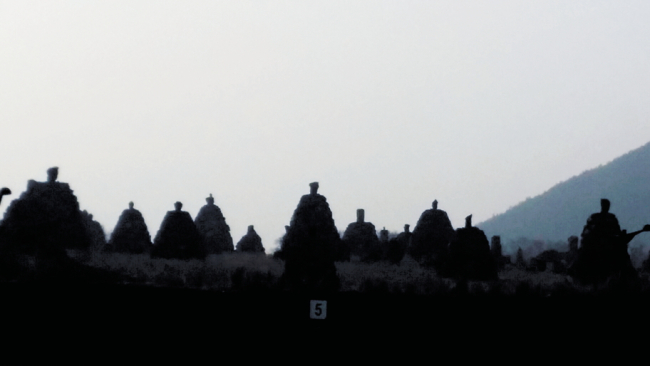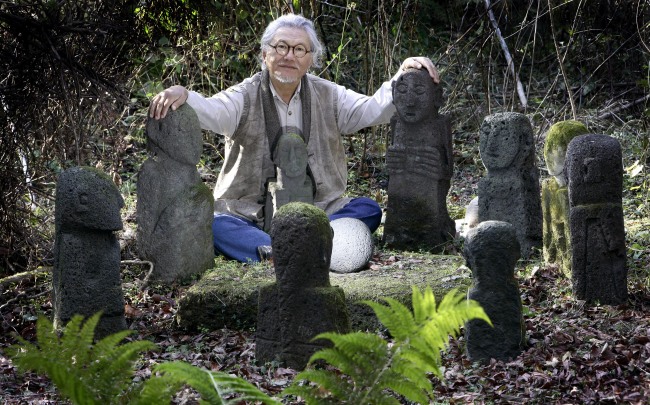[Weekender] A singular vision realized
For stone collector Paek Un-chol, Jeju Stone Park is a 20-year labor of love
By Korea HeraldPublished : May 2, 2014 - 21:05
JEJU, Jeju Province ― More than an hour’s drive from Seogwipo in the southwestern part of Jejudo Island, numerous gigantic stone piles that resemble abstract human figures rise out of nowhere. “That is Jeju Stone Park,” says the bus driver.
The 500 stone piles, each topped with a large rock for the head, represent the 500 Generals of a popular Jeju myth, and are part of the sprawling, 327-hectare Jeju Stone Park.
One is awestruck by the scale of the park ― which currently includes a garden based on the theme of Jejudo Island’s mythology, the Jeju Stone Museum, the outdoor Jeju Stone Cultural Exhibition Hall, a traditional Jeju village of thatched-roof houses, a gallery and the 500 Generals.
The 500 stone piles, each topped with a large rock for the head, represent the 500 Generals of a popular Jeju myth, and are part of the sprawling, 327-hectare Jeju Stone Park.
One is awestruck by the scale of the park ― which currently includes a garden based on the theme of Jejudo Island’s mythology, the Jeju Stone Museum, the outdoor Jeju Stone Cultural Exhibition Hall, a traditional Jeju village of thatched-roof houses, a gallery and the 500 Generals.

That the concept for the park sprang entirely from the mind of one man, a singular man devoted to all things Jeju and stones in particular, takes many by surprise. In fact, Paek Un-chol, general director of planning, design and installation for Jeju Stone Park, conceived the idea, proposed the project to the local government and has been overseeing the execution of his concept for more than 15 years now.
By the time Paek signed a deal with North Jeju County ― now part of Jeju City ― in January 1999, donating his entire collection of stones and tree roots in exchange for a 327-hectare lot and 200 billion won ($194 million) investment for the proposed Jeju Stone Park, he had been collecting rocks for more than 30 years and running Tamla Mok Seok Won, a park featuring stones and unusual root formations, since 1971.
“It all started as a hobby some 40 years ago,” said Paek, his silvery hair in a ponytail under a cap, at his office in a container box located on the edge of the park in mid-March.
It was while serving in the army at Mount Seoraksan in Gangwon Province, where his duty was to collect wood for the company commander’s fireplace, that Paek encountered strangely shaped tree roots and began collecting them. “On Saturdays and Sundays I collected stones in the nearby Hangyecheon Stream because I was bored,” Paek recalled.
A Jeju native, Paek began collecting the strange roots in earnest in 1969, scaling Mount Hallasan. At one point, he collapsed from exhaustion and his mother brought him to Yeongsil, a section of Mount Hallasan considered sacred and second in importance only to Baegnokdam, the crater lake on the top of the dormant volcano, to pray to the mountain gods for his recovery.
“During the weeklong stay there, my mother prayed while I looked around. I saw the silhouettes of 500 Generals in the moonlight and felt the urge to put heads on them,” Paek said. The 500 Generals are the unusual rock formations found in the southwestern part of Mount Hallasan and are named after the 500 generals of a well-known Jeju myth. The 500 Generals would later become one of the central themes of Jeju Stone Park.

Upon returning from the mountain, Paek headed to Baeophwan Port on the southern part of Jejudo Island, where he found stones that he could use as the generals’ heads. “I lived in an orchard by the beach for a year and hauled 500 stones,” Paek said.
In 1971, Paek opened Tamla Mok Sok Won, just as Jejudo Island was being promoted as a tourism destination.
“During the park’s heyday in the ’70s, ’80s and early ’90s, we received as many as 160,000 visitors a year,” he said. With money from the park and bank loans, he embarked on a nearly decadelong collecting frenzy, buying pieces for the yet-to-be realized park that was still just a vision in his head.
With the number of visitors to the park dwindling through the 1990s as Koreans began taking holidays abroad, Paek closed Tamla Mok Sok Won in 2009 after its entire collection ― some 20,000 stones and tree roots, equivalent to 500 loads carried by 15-ton trucks ― was moved to Jeju Stone Park.
Eco, culture park
“I don’t want to merely exhibit stones. I want to show Jeju’s identity, its folklore and its artistic nature,” said Paek of his vision for Jeju Stone Park. “Stones run through the mythology, folklore and history of Jeju,” he added.
To realize his vision, Paek has tapped into two well-known local myths: the creation myth of Seolmundae Halmang, a gargantuan goddess who created Jejudo Island and the surrounding islands, and the myth of the 500 Generals who turned into stone after realizing that the porridge they had eaten contained their mother, who had jumped into the boiling cauldron to feed her children. Paek combined the two mythologies to create a story in which Seolmundae Halmang is the mother of the 500 Generals.
“Seventy percent of the land is protected wooded area and kept clear of structures, reflecting the Earth, which is 70 percent water and 30 percent landmass,” Paek said.
“This is not just a tourism product. It was planned as something to hand down to generations after us,” Paek said.
Ironically, Paek was able to collect his stones and tree roots because there was no awareness of the need for nature conservation at the time. “Critics say that the stones and tree roots are ‘orphans’ because they have been taken away from their natural habitats. On the other hand, there are those who believe there is value in gathering them in one place,” Paek said.
The collector is also a conservationist. “The beach off Tap-dong in Jeju City with its basalt should have been preserved, but the city continues to pour concrete over the stones to build breakwaters,” he said. “Beophang Beach also needs to be designated for preservation,” he added.
Only 40 percent of construction at Jeju Stone Park has been completed so far. Up to 60 percent of the construction will go toward building the Seolmundae Halmang Complex, which will take the form of the gargantuan goddess.
By the time the second phase of development is completed in 2020, Paek will be in his 80s. “I would be happy to stay on to clean the place or serve as a guide,” Paek said with a smile.
By Kim Hoo-ran, Senior writer
(khooran@heraldcorp.com)
-
Articles by Korea Herald







![[Graphic News] More Koreans say they plan long-distance trips this year](http://res.heraldm.com/phpwas/restmb_idxmake.php?idx=644&simg=/content/image/2024/04/17/20240417050828_0.gif&u=)
![[KH Explains] Hyundai's full hybrid edge to pay off amid slow transition to pure EVs](http://res.heraldm.com/phpwas/restmb_idxmake.php?idx=644&simg=/content/image/2024/04/18/20240418050645_0.jpg&u=20240419100350)






![[From the Scene] Monks, Buddhists hail return of remains of Buddhas](http://res.heraldm.com/phpwas/restmb_idxmake.php?idx=652&simg=/content/image/2024/04/19/20240419050617_0.jpg&u=20240419175937)

![[KH Explains] Hyundai's full hybrid edge to pay off amid slow transition to pure EVs](http://res.heraldm.com/phpwas/restmb_idxmake.php?idx=652&simg=/content/image/2024/04/18/20240418050645_0.jpg&u=20240419100350)

![[Today’s K-pop] Illit drops debut single remix](http://res.heraldm.com/phpwas/restmb_idxmake.php?idx=642&simg=/content/image/2024/04/19/20240419050612_0.jpg&u=)